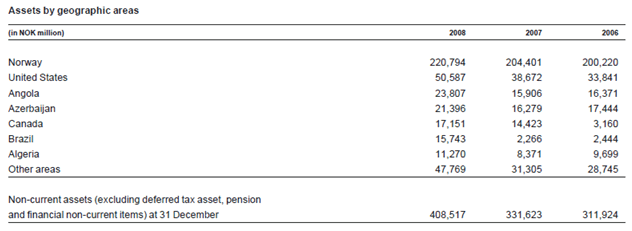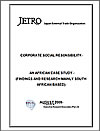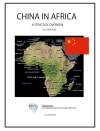 Statoilhydro
Statoilhydro
All data are collected in the Fiscal Year of 2008-2009.
Company Profile and History
StatoilHydro is a Norwegian energy company, formed by the 2007 merger of Statoil with the oil and gas division of Norsk Hydro. StatoilHydro is the biggest offshore oil and gas company in the world and the largest company by revenue in the Nordic Region. By market cap StatoilHydro is in 2008 ranked by Fortune Magazine as the world's 11th largest oil and Gas Company, and as the world’s 59th largest company. Statoil's shareholders hold 67.3% of the new company, with Norsk Hydro shareholders owning the remaining 32.7%. The Norwegian Government, the biggest shareholder in both Statoil and Norsk Hydro, holds 62.5% of the company
Statoil (Den Norske Stats Oljeselskap) was founded as a private limited company owned by the Government of Norway on July 14, 1972. The company was privatised and made a public limited company in 2001, becoming listed on the both the Oslo Stock Exchange and the New York Stock Exchange. The government still retained a majority ownership in the company.
Financed by the Swedish Wallenberg family and French banks, Norsk Hydro ASA was founded on December 2, 1905 by Sam Eyde, exploiting a new technology for producing artificial fertilizers by fixing nitrogen from air. In 1965 Hydro joined Elf Aquitaine and six other French companies to form Petronord to perform search for oil and gas in the North Sea. Hydro soon became a large company in the North Sea petroleum industry, and also became operator of a number of fields, the first being Oseberg. In 1999 Hydro acquired Norway's third largest petroleum company Saga Petroleum, which had major upstream operations primarily in Norway and the United Kingdom. The British operations were later sold.
StatoilHydro has been operating in Angola for the past 17 years and are now partners in nine producing fields. The two companies’ earliest involvement in Angola was in Total’s bid for Angola’s Block 17. Statoil got 13.3% of Block 17 and Norsk Hydro 10%. Angola is one of Statoil's core areas outside Norway. Statoil's office in Angola was established in 1999.
In Country Location
Rua Major Kanhangulo, 86
Ingombota
Tlf: +244 222 398798
Faks: +244 222 398797
Rua de Benguela No. 17
Patrice Lumumba
Tlf: + 244 222 640 900
Faks: +244 222 640 999
Luanda
Angola
Services and Products
StatoilHydro is an integrated technology-based international energy company primarily focused on upstream oil and gas operations. In addition to the Norwegian continental shelf, StatoilHydro operates oil and gas fields in Algeria, Angola, Azerbaijan, Brazil, Canada, China, Iran, Libya, Nigeria, Russia, United States and Venezuela. StatoilHydro is also involved in a number of pipelines, including Zeepipe, Statpipe, Europipe I and Europipe II, and Franpipe from the Norwegian continental shelf to Western Europe in addition to the Baku-Tbilisi-Ceyhan pipeline in Central Asia.
The company has trading offices for crude oil, refined petroleum products and natural gas liquids in London, Stamford and Singapore. The company operates three brands of fuel stations: Statoil, Hydro and 1-2-3. In total StatoilHydro has about 2,000 fuel stations.
Number of Employees
The Group had approximately 29,500 employees as of 31 December 2008 and 43 workers in Angola including 23 locals.
Financial Information
Revenues and other income totalled NOK 656.0 billion in 2008, a NOK 133.2 billion increase from 2007. Most of the revenues derive from the sale of lifted crude oil, natural gas and refined products produced and marketed by StatoilHydro. Total natural gas sales were 45.2 bcm in 2008 and 42.0 bcm in 2007. Total equity production of oil and gas increased from 1.839 mboe per day in 2007 to 1.925 mboe per day in 2008. Total entitlement production increased from 1.724 mboe per day in 2007 to 1.751 mboe per day in 2008.
Revenue


Geographical data for the year ended 31 December 2008

Market Share
In total, StatoilHydro’s total production in Angola is now over 200,000 barrels of equity production per day, representing more than 10% of the total daily production in Angola.
Girassol alone had delivered 10% of an average of 200,000BOPD production to Hydro since 2001 and 13.3% of the same to Statoil. With the merger into Statoil Hydro in 2007 and Total bringing Dalia field into production in 2008, StatoilHydro’s investment n Block 17 contribute over 110,000BOPD of equity production to the company.

Business Objective
Its ambition is to be a globally competitive company. The objective of StatoilHydro “is to create long-term value for shareholders through exploration, production, transportation, refining and marketing of petroleum and petroleum derived products.”
Business Model
Exploration drilling is StatoilHydro's primary tool for growing its business. The company plans to continue to optimise the large portfolio of exploration assets. A major success of its business model is the fact that it is involved in nearly every element of the oil and natural gas industries, which saves hundreds of millions in outsourcing costs, and adds just as much from multiple income streams. Its globally integrated operations also ensure that the company will generate more revenue streams and better returns for investors.
StatoilHydro also relies on a vast range of technologies in its operations. The group is therefore reliant on research and development internally and externally in order to discover new technologies to create value for its core business. Venture capital investment is also a vehicle for supporting StatoilHydro’s growth ambitions. Investments are made in ambitious technology companies with unique value propositions in the energy sector.
Ownership of Business
StatoilHydro’s current asset portfolio in Angola comprises a 20% working interest in block 4/05; 13.33 % in block 15; 13.33 % in block 31; 5 % in block 15/06; 23.33 % in block 17; and a 50 % interest in block 34.
Benefits Offered and Relations with Government
Norway has historically played a leading role in the provision of humanitarian aid. Since the signing of the peace agreement in 2002 the focus has sifted to development projects In January 2007 Norsk Hydro signed a MoU with Angola for primary aluminium projects in Angola.
Norsk Hydro formed a series of alliances and partnerships in Angola, offering scholarships for Angolan engineers and establishing a technology transfer centre for Sonangol employees. That pro-active stance helped Norsk Hydro to become Sonangol’s special partner, particularly on block 34 in the deep offshore. Norsk Hydro is also the only Western oil company operating in Angola to have teamed up with Somoil, a local firm with connections with Sonangol’s management and the office of the country’s oil minister and ACR, a firm owned by Carlos Amaral, a former Sonangol executive. Each of the two holds 15%.
Product Development
StatoilHydro indicated that it is interested in developing deepwater and pre salt drilling off shore Angola. Angola shares a similar underwater rock formation as Brazil, which in 2007 recorded a new so-called pre salt discovery of some 8 billion barrels of crude in its Tupi field. Brazil's success with pre salt provided fresh impetus for similar exploration in Angola, with StatoilHydro leading the way.
In May 2009 another discovery has been made on the prolific ultra-deep water block 31 offshore Angola in which StatoilHydro has a 13.33% stake.
Block 4/05 Block 4/05 is in the development phase, with a large area with remaining exploration potential. Sonangol P&P is the operator of block 4/05, and StatoilHydro is heavily involved in the operations through personnel seconded to Sonangol P&P's project organisation.




